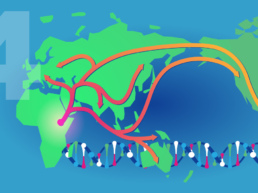Development experts at the World Bank, and The Economist debate Professor Eric Maskin’s theory on the effects of globalization on developing economies. While their analysis are both informative and insightful, they invariable serve as critiques of Maskin’s theory on why globalization may not be so helpful to developing economies, at least at this stage of the process.
The Economist:
DEFENDERS of globalisation often say that, whatever distress it may cause for rich-world workers, it has been good for poor countries. Between 1988 and 2008, global inequality, as measured by the distribution of income between rich and poor countries, has narrowed, according to the World Bank. But within each country, the story is less rosy: globalisation has resulted in widening inequality in many poor places. This can be seen in the behaviour of the Gini index, a measure of inequality. (If the index is one, a country’s entire income goes to one person; if zero, the spoils are equally divided.) Sub-Saharan Africa saw its Gini index rise by 9% between 1993 and 2008. China’s soared by 34% over 20 years. In few places has it fallen.
Economists are puzzled: the data contradict the predictions of David Ricardo, one of the founding fathers of their discipline. Countries, said Ricardo, export what they are relatively efficient at producing. Take America and Bangladesh now. In America the ratio of highly skilled to low-skilled workers is high. In Bangladesh it is low. So America focuses on products requiring highly skilled labour, such as financial services and software. Bangladesh focuses on downmarket products such as garments.
Comparative advantage predicts that when a poor country starts to trade globally, demand for low-skilled workers will rise disproportionately. That, in turn, should boost their wages relative to those of higher-skilled locals, and so push down income inequality within that country. The theory neatly explains the impact of the first wave of globalisation. In the 18th century, Europe had a high ratio of low-skilled workers relative to America. When Euro-American trade took off, European inequality duly tumbled. In France in 1700 the average real incomes of the top 10% were 31 times higher than the bottom 40%. By 1900 (admittedly after several revolutions and wars) they were 11 times larger.
But growing inequality in developing countries leaves Ricardo’s disciples befuddled and suggests the theory needs updating. Eric Maskin of Harvard University has attempted just this at the Lindau Meeting on Economic Sciences, a get-together of economists in a Bavarian lakeside town featuring many Nobel laureates. (Mr Maskin won his in 2007 for his work on the design of market mechanisms, which economists use to improve regulation schemes and voting systems.)
Mr Maskin’s theory relies on what he calls worker “matching”. Unskilled workers can be more productive when matched with skilled ones—that is, when they work together. Assigning a manager to a group of workers can do more for total output than just adding another worker. He places workers into four classes: skilled workers in rich countries (A); low-skilled workers in rich countries (B); high-skilled workers in poor countries (C); and low-skilled workers in poor countries (D). Crucially, he thinks low-skilled workers in rich countries (the Bs) are likely to be more productive than high-skilled workers in poor ones (the Cs).
Before the current wave of globalisation started in the 1980s, skilled and unskilled workers in developing countries—the Cs and Ds—worked together. Mr Maskin gives the example of a rural Indian man, fluent in English, who helped local farmers understand modern agricultural methods. Wage growth of high-skilled workers (Cs) was weak, because poor transport and communication links made it hard for them to work with skilled workers in rich countries. But low-skilled workers (Ds) did well: their interactions with the Cs boosted total output, which let them demand higher wages, so pushing down inequality.
The latest bout of globalisation has jumbled the pairings: high-skilled workers in poor countries can now work more easily with low-skilled workers in rich ones, leaving their poor neighbours in the lurch. Take “intermediate goods”, the semi-finished products that account for about two-thirds of world trade. The production processes outsourced by big companies in factories or call-centres are by rich-world standards unskilled. But when jobs are sent offshore, they are snapped up by C workers, the relatively skilled ones. According to research from Cornell University, the typical call-centre employee in India has a bachelor’s degree.
Globalisation in its latest guise means such workers come into more regular contact with less-skilled people in the rich world. The Anglophone Indian cited by Mr Maskin may go to work in an export factory where he meets tight deadlines laid down by its American owners. The Cs work with Bs and end up being more productive. The Ds are left by the wayside.
D-graded workforce
The result of booming trade in intermediate goods is higher demand and productivity for skilled poor-country workers. Higher wages ensue: multinationals in developing countries pay manufacturing wages above the norm for the country. One study showed that in Mexico export-oriented firms pay wages 60% higher than non-exporting ones. Another found that foreign-owned plants in Indonesia paid white-collar workers 70% more than locally owned firms. Globalisation, though, does not boost wages for all. The least skilled cannot “match” with skilled workers in rich countries; worse, they have lost access to skilled workers in their own economies. The result is growing income inequality.
Mr Maskin’s approach is not entirely satisfying. He does not offer data to back up his theory (such is the privilege of the Nobel laureate). “We need micro-data on matches between firms in developing countries to examine whether skilled workers benefit through the mechanism Mr Maskin suggests,” says Pinelopi Goldberg of Yale University. But if he is right, he poses a challenge to globalisation’s advocates: figuring out how to reap its rewards without leaving the least-skilled in poor countries behind.
The World Bank:
Proponents of globalization, who point to the boon that results from the trade in goods and services between countries, argue that global integration increases average income within countries, and also reduces inequality. The antecedent for this view is typically attributed to 19th century British economist David Ricardo, who came up with the notion of ‘comparative advantage’ between countries. Witnessing firsthand the benefits of trade as a result of industrialization and cheap transportation (steamships and railways), Ricardo recommended that nations concentrate solely on those industries in which they are more competitive relative to other nations, and trade with other countries for all other products. Industry specialization and international trade, theorized Ricardo, always make countries better off.
Looking at the current wave of globalization, Nobel Laureate Eric Maskin of Harvard University arrives at a different conclusion. Maskin theorizes that while average income has been rising as a result of more trade and global production, so has inequality within countries. Inequality resulting from globalization today is often viewed as existing in two varieties, one ‘less worse’ than the other.
In the ‘less-worse’ version, inequality is tolerated as a necessary side-effect of increased economic growth within a country. Through globalization, goes the argument, the wages of a segment of the work force increase, but the same doesn’t happen for other segments, so the gap in between increases.
In the ‘worse’ version, the wages of a segment of the work force (usually low-skilled and low-wage workers) drop as a result of less demand for their skills, while the wages of higher-skilled workers increase. Maskin, who was discussing his alternative theory (developed in collaboration with Michael Kremer) at the 2014 Annual Bank Conference on Development Economics, worries about this ‘worse’ version.
Globalization today, says Maskin, is a phenomenon wherein the very production of goods and services has become international, as in the case of the iPhone, which is designed in Palo Alto, but physically manufactured in a range of countries, including China, Japan and Germany.
How skills match between workers, says Maskin, lies at the crux of understanding why globalized production leads to an increase in inequality. The better the match in skills between workers, the less the inequality.
Furthermore, whether that match happens within a country or across countries, matters. If an individual with a higher skill level (let’s say someone working in a food processing plant) matches better with someone with a lower skill (a farmer), the lower-skilled worker will benefit (for example, through the transfer of ideas and work ethics) from working with the higher skilled worker.
However, if the higher skilled worker is better suited to work with an even more advanced worker (let’s say a product designer) located in an advanced economy, that worker will be incentivized to look across his or her borders. As a result, the farmer with lower skills gets knocked out of the globalization process.
More worryingly, this situation potentially has an impact on the wages the lower skill worker can command. The higher skilled worker, as a result of rising international demand for his or her skills, experiences a rise in wages. The opposite can happen for the low-skilled worker.
This poses a conundrum for those concerned about inequality (and at first blush, ammunition to those cynical of the benefits of globalization). How does one reconcile the visible benefits of globalization with the apparent downside?
The answer, says Maskin, lies in contrasting the benefits to an economy as a whole against the negative effects on a certain segment of workers.
“The right thing to do is not to try to stop globalization – that would be foolish -because globalization certainly does increase average income in all countries,” says Maskin.
“Rather, what we want to do,” says Maskin, who confesses admiration for Ricardo’s insights, “is allow the low skilled workers of the world to share in the fruits of globalization.”
How exactly does this happen?
Maskin doesn’t have an easy solution, but proposes a path of raising skill levels by offering job training to low-skilled workers so they can match better with international opportunities. Even if this were to be adopted as the most expedient way to tackle the challenge, a question that vexes Maskin even more is ‘who is willing to pay to improve the skills of these workers?’ The workers themselves can’t afford to, says Maskin, and companies in need of more labor won’t want to either, because that will eventually lead to a demand for higher wages.
The most viable option, argues Maskin, is for third parties like governments, multilateral institutions, NGOs and private foundations to step in.



